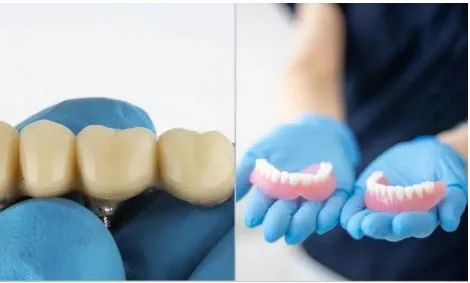Dentures vs. Crowns: Which Option is Better for You?
Choosing between dentures vs. crowns can feel confusing—both restore smiles, improve function, and protect oral health, but they solve different problems. The right choice depends on how many teeth are affected, the condition of your remaining tooth structure, your budget, and your long-term goals for comfort and aesthetics. This guide breaks down what each option is, when each makes the most sense, and how to decide with confidence alongside your dentist.
Dentures vs. Crowns at a Glance
- Crowns: Caps that cover and protect a single tooth (or individual implants). Ideal when a tooth is cracked, heavily filled, root-canal treated, or worn down—but still present.
- Dentures: Removable appliances that replace multiple missing teeth (partials) or all teeth in an arch (complete dentures). Ideal when several teeth are missing or non-restorable.
In short: if you still have a rebuildable tooth, a crown is often the fix. If you’re missing many teeth—or the remaining teeth can’t be saved—dentures are the more comprehensive solution.
What Is a Dental Crown?
A crown is a custom, tooth-shaped “cap” that fits over a prepared tooth (or an implant abutment). Modern crowns are typically porcelain, zirconia, porcelain-fused-to-metal, or full metal (like gold). Your dentist reshapes the tooth, takes a scan or impression, and a lab (or in-office system) fabricates the crown to match your bite and shade.
Best for:
- Large fractures or cracks
- Teeth with big fillings that keep failing
- Root-canal–treated teeth (which are more brittle)
- Cosmetic reshaping and color correction of a single tooth
- Protecting worn or eroded teeth
Pros:
- Feels and functions like a natural tooth
- Excellent aesthetics with modern ceramics
- Fixed (not removable)
- Helps preserve existing tooth and bone
Cons:
- Requires removal of some tooth structure
- Not an option if too little healthy tooth remains without additional procedures
- Costs add up if many teeth need crowns
What Are Dentures?
Dentures are custom, removable prosthetics that replace several teeth (partial dentures) or a full arch (complete dentures). The base is usually acrylic; teeth can be acrylic or composite. Metal frameworks may be used in partials for strength and slimmer profile.
Best for:
- Multiple missing or non-restorable teeth
- Full-arch replacement (when most or all teeth are lost)
- Interim restoration while planning implants or complex treatment
Pros:
- Restores smile and chewing across many missing areas
- Generally lower upfront cost per tooth replaced
- Non-invasive (no drilling on neighboring teeth)
- Can be updated or relined as your mouth changes
Cons:
- Removable—requires daily insertion, removal, and cleaning
- May feel bulkier than natural teeth
- Lower chewing efficiency than natural teeth or fixed options
- Fit can change over time as bone resorbs, requiring relines or replacements
Key Differences That Drive the Decision
When weighing dentures vs. crowns, consider these dimensions:
- Purpose & Scope
- Crowns rehabilitate an individual tooth (or an implant) to save and strengthen it.
- Dentures replace multiple missing teeth (or all teeth) and restore overall arch form.
- Permanence
- Crowns are fixed—you don’t remove them.
- Dentures are removable and rely on tissue support, clasps, or adhesive.
- Tooth/Bone Preservation
- Crowns keep your natural root in place, helping maintain jawbone stimulation.
- Dentures don’t stimulate bone; without tooth roots or implants, bone tends to resorb gradually.
- Comfort & Adaptation
- Crowns usually feel natural quickly.
- Dentures have an adaptation period (saliva changes, gag reflex, sore spots) that improves with adjustments.
- Chewing Efficiency
- Crowns on stable teeth approach natural bite efficiency.
- Dentures improve function compared with missing teeth but are typically less efficient than fixed restorations.
- Maintenance
- Crowns: brush/floss like normal; use floss threaders or water flossers around bridged areas.
- Dentures: daily removal, brushing, soaking; clean gums/tongue; store moist when not in use.
- Longevity
- Crowns commonly last many years with good hygiene and bite balance.
- Dentures often need periodic relines and replacement as fit changes over time.
When Crowns Make the Most Sense
- You have a single tooth that’s badly decayed, cracked, or weakened, but saveable.
- You’ve had a root canal and need to protect the tooth from fracture.
- A tooth looks dark or misshapen and you want a cosmetic correction that also strengthens it.
- You want a fixed solution that feels like a natural tooth.
Tip: If the tooth is too damaged to hold a crown, your dentist might build it up with a core or place a post after a root canal. If the tooth cannot be predictably restored, extraction plus an implant crown, bridge, or partial denture becomes the conversation.
When Dentures Make the Most Sense
- You’re missing several teeth across an arch, and restoring each site with implants or bridges isn’t practical right now.
- Your remaining teeth have a poor long-term prognosis due to decay, fractures, or advanced gum disease.
- You need a cost-conscious way to restore appearance and function quickly.
- You want a transition solution while planning staged implants or grafting.
Tip: Ask about implant-assisted dentures (e.g., two to four implants with attachments). They dramatically improve stability and chewing compared with traditional tissue-supported dentures.
The Procedure Timeline: What to Expect
For a Crown
- Diagnosis & planning: X-rays, photos, and bite assessment.
- Preparation & temporary: The tooth is shaped; a scan or impression is taken. You’ll wear a temporary crown.
- Final placement: The lab-made crown is adjusted and cemented. Same-day crowns are possible in some offices.
For Dentures
- Records: Impressions/scans, bite registration, shade selection.
- Try-in (for some cases): A wax version to preview fit and smile.
- Delivery: Final denture insertion and adjustments.
- Follow-ups: Sore-spot relief and fit checks; later relines as tissues settle.
Cost Considerations (and Insurance)
- Crowns: Typically priced per tooth; materials (zirconia, porcelain, metal) and needed procedures (core buildup, root canal) influence cost.
- Dentures: Priced per arch or partial; complexity, materials, and extractions/relines add to the total.
Dental insurance often contributes to both—but coverage varies widely. Ask for a pre-treatment estimate so you understand your copay and alternatives. Remember that while dentures might have a lower upfront cost per tooth replaced, crowns (or implants) may offer greater long-term stability and chewing performance when feasible.
Aesthetics: What Will Look Most Natural?
- Crowns can be nearly indistinguishable from natural teeth, especially with modern ceramics and custom shading.
- Dentures can also look very natural, particularly when tooth shape, size, and gingival contours are customized. However, the bulk of the acrylic base and the way light passes through denture teeth can differ from natural enamel.
If a seamless match to adjacent natural teeth is a top priority for a single tooth, a high-quality ceramic crown often wins.
Care & Maintenance
Crowns
- Brush twice daily with fluoride toothpaste; floss every day.
- Use a nightguard if you grind or clench to protect from chipping.
- Keep recall visits for bite checks and professional cleanings.
Dentures
- Remove and rinse after meals; brush with a soft brush and non-abrasive cleaner.
- Soak overnight in a denture solution; never use hot water (it can warp acrylic).
- Brush your gums, tongue, and palate daily to keep tissues healthy.
- See your dentist for relines as your mouth changes.
Common Myths, Debunked
- “A crown kills the tooth.”
False. A crown covers and protects; it doesn’t “kill” the tooth. A root canal (when needed) removes infected pulp, not the crown itself. - “Dentures mean I can’t eat what I love.”
Partly false. While very hard or sticky foods may remain tricky, many people eat a wide variety of foods with well-fitting dentures—especially when implants add stability. - “Crowns are purely cosmetic.”
False. They’re primarily functional restorations that also improve appearance.
Decision Checklist: Which Is Better for You?
Use this quick self-assessment before your consultation:
- How many teeth are the issue?
One or two restorable teeth → crown likely. Several missing or failing teeth → denture (possibly implant-assisted). - Is the tooth saveable?
Enough healthy structure and good gum support → crown. Non-restorable or severe periodontal problems → extraction and replacement (denture, bridge, or implant). - Do you prefer fixed or removable?
Prefer fixed → crown (or fixed bridge/implant). Okay with removable and want to replace many teeth at once → denture. - Budget and timeline?
Need full-arch replacement quickly at lower upfront cost → denture. Investing in single-tooth strength and aesthetics → crown. - Long-term plan?
Want maximum stability and bone preservation → consider implants (with crowns or implant-retained dentures).
The Bottom Line on Dentures vs. Crowns
When deciding between dentures vs. crowns, the most important factor is whether the tooth (or teeth) in question can be predictably saved. Crowns excel at reinforcing and beautifying individual teeth you still have. Dentures shine when you need to replace many teeth at once, restore your smile quickly, and manage costs—especially as a bridge to future implant therapy. Many patients ultimately choose a hybrid path, using crowns on saveable teeth and a partial denture for gaps, or integrating implants for the best blend of stability, function, and appearance.
Your best next step is a comprehensive exam with X-rays and a bite analysis. Bring your priorities—fixed vs. removable, budget, timeline, aesthetics—and ask your dentist to map out two or three scenarios (with pros, cons, and costs) so you can make a confident, personalized choice.





